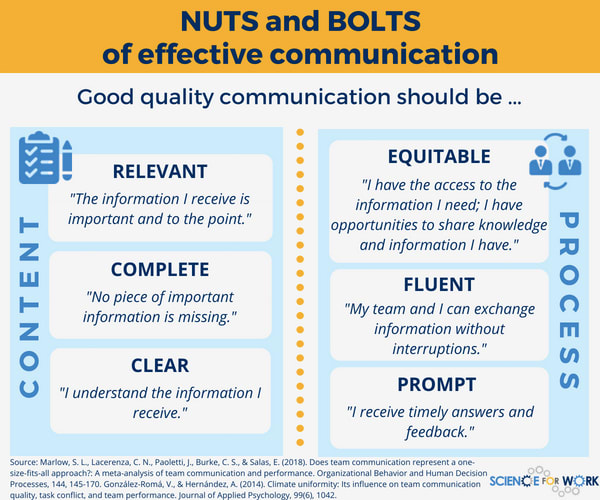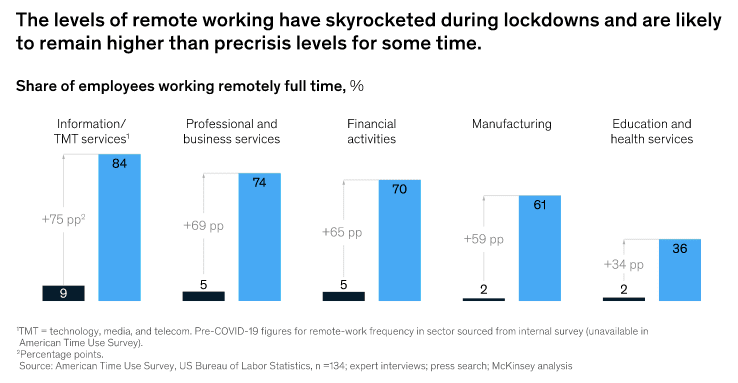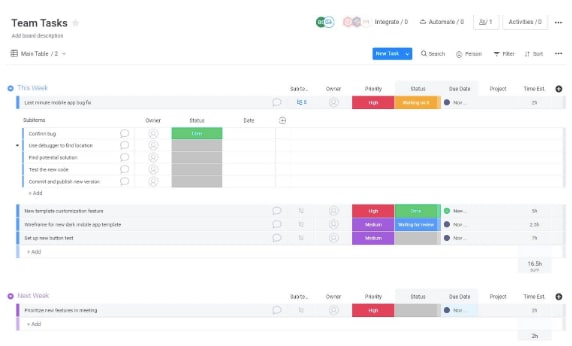Let’s face it: communication is hard.
Things get misunderstood, people read between the lines, and emotions cloud our judgment.
In an ideal world, team communication would be smooth, effective, and respectful.
But the reality is that when humans are involved, it doesn’t always work that way — and with more people now working remotely than ever before, communicating well can be challenging.
This article will explain what effective team communication is and why it matters for your business, as well as making recommendations for overcoming common team communication challenges.
What is effective team communication, and why does it matter?
Communication is the process of getting an idea or concept out of your head and translating it into information that other people can understand.
Since we’re not telepathic, we need communication in order to work effectively together.
Effective communication can be broken down into 2 factors: content (what you say) and process (how you say it).
In a work context, the content should be relevant, complete, and clear, while the process should be equitable, fluent, and prompt.

What are the 5 types of team communication?
So how does a team actually communicate? Let’s take a look at the 5 types of communication.
#1. Verbal communication
Verbal — or oral — communication is the process by which 2 or more people communicate in-person, on a phone call, or via video conference.
We communicate verbally all the time — from the moment you wake up in the morning to the moment you fall asleep.
In spite of the plethora of technology options available for communication — such as email and instant messaging — many people still prefer to pick up the phone or have a face-to-face meeting.
This is because verbal communication is often more effective and efficient than written communication, such as emails.
#2. Nonverbal communication
Also known as interpersonal communication, nonverbal communication is everything we don’t say with our words.
Nonverbal communication is all about our body language — including facial expressions, hand movements, eye contact, and posture — and it can often be more powerful than the words we use.
Have you ever been in a situation where a colleague said one thing, but their body language told a different story?
Perhaps they agreed with you verbally, but as they did so, they crossed their arms, slouched their shoulders, sighed, and looked out the window — leaving you with the distinct impression they did not agree.
That’s you interpreting their non-verbal communication.
#3. Listening
When you think of effective communication, you might think about the best ways to express yourself in a way that’s understandable for your teammates.
But do you ever think about how important listening is as a communication skill?
Often when someone is talking, we spend a lot of the time thinking about what we’re going to say next and waiting for our turn to say it.
This can lead to misunderstandings and miscommunication because we often assume we know what someone will say, which means not actually listening to them.
Active listening is an essential skill for leaders to develop and encourage among their team members.
It requires you to focus on what the person is saying, then repeat it back to them to check if you have understood correctly.
#4. Written communication
Modern businesses live and die by written communication, which includes:
- Email and messaging
- Reports
- Company policy documents
- Press releases
- Social media posts
- Contracts
- Memos
- Advertisements and sales pages
- Marketing campaigns
- Customer interactions
Getting these right is essential, as your written communication skills can make or break your credibility as a leader, affect your chances of promotion, or even harm your company reputation.
#5. Visual communication
We live in a visual world.
Thanks to social media, we’ve grown accustomed to communicating through images, photos, memes, infographics, and videos.
At monday.com, we know that information is easier to digest in a visual format, which is why we created our dashboard views to help you visualize data in a way that makes sense to you.

Bonus: formal vs. informal communication
While formal communication — such as meetings and yearly appraisals — is essential for running a team effectively and efficiently, it’s important not to underestimate the power of informal communication.
Informal conversations build trust among team members and between employees and their managers.
Informal communication has become more challenging with the rise of remote work, so leaders of remote teams should consider organizing activities that encourage informal interactions, such as virtual coffee breaks.
How does communication affect team performance?
While there’s little conclusive research on the link between communication and team performance, evidence suggests that employee engagement levels are strongly correlated with team performance.Generally, people like to create value, so — if the team is performing well — they’re more likely to be engaged.
And what helps teams to perform well? Employees who are empowered to communicate and collaborate effectively to get work done.
According to Gallup, greater levels of employee engagement lead to fewer negative outcomes and more positive outcomes, which means greater success for your organization.
Some of the benefits Gallup found of employee engagement include:
- 81% decrease in absenteeism
- Decreased employee turnover
- 18% increase in sales
- 23% increase in profit
- 66% increase in employee well-being
8 common team communication challenges (and how to fix them)
So what prevents your team from communicating effectively, and how can you help them overcome those challenges?
Let’s take a look at some of the most common team communication issues and possible solutions.
#1. Lack of effective leadership
If you’re a team leader, the idea that you may be part of the problem can be a hard pill to swallow.
But the simple fact is that managers set the tone for how their whole team communicates.
If your teammates are afraid to speak up, it means there isn’t an environment of trust — and as a leader, it’s your responsibility to create one.
Solutions:
Take an honest look at your own communication style and look for ways to create a culture of open communication between your team members.
Consider having an open-door policy that encourages colleagues to approach you with their concerns.
You might even want to have your team complete an anonymous survey that will provide valuable feedback for improving your leadership and communication skills.
#2. Unclear roles and responsibilities
If your team members don’t know where their role ends and their colleague’s begins, be prepared for a lot of crossed wires, confusing email chains, duplicated work, and lost time.
Solutions:
Managers must make sure that each team member knows what their roles and responsibilities are.
Clarify any confusion surrounding roles by clearly documenting them and making the documentation available and accessible to your colleagues.
Hold regular progress meetings to check in with your team and respond to any doubts they may have about their work.
#3. Remote work
The COVID-19 outbreak forced the majority of businesses to take up remote work more quickly than they may have intended, as the image below shows.

Virtual communication poses its own set of challenges since the lack of face-to-face communication and the inability to read nonverbal cues can lead to misunderstandings.
When working remotely, people either don’t communicate enough, or they communicate too much, making communication ineffective.
Solutions:
If you’re a leader in your organization, prioritize planning face-to-face events, where possible, that can help your team get to know each other and encourage more open and fluid communication.
You might also want to consider investing in software that facilitates communication and collaboration.
#4. Lack of trust among team members
Which came first: trust or good communication?
Without trust, you can’t have effective communication, but without effective communication, you can’t build trust.
Solutions:
Informal coffee breaks or other activities that encourage colleagues to engage in informal conversation can help build trust among your team members.
An excellent — and fun — activity for building trust among team members is an escape room, which forces people to work together toward a shared goal. Kind of like work.
#5. Different communication styles
Different personalities have different communication styles.
Extroverts tend to think out loud and love engaging in group activities such as brainstorming meetings.
Introverts, on the other hand, take longer to process and reflect on information and may prefer to work alone.
Unfortunately, it’s often a case of the squeaky wheel getting the oil, with introverts being overlooked in favor of their noisier counterparts.
This is a loss to any organization, since introverts often contribute insights and ideas that can benefit everyone.
Solutions:
Have your team take an MBTI test to discover their personality types. Tailor your communication style to each individual, and provide spaces for interaction and exchange that favor both introverts and extroverts.
You could also consider having your team participate in communication training and creating internal communication guidelines that are available to all current and new employees.
#6. Working across different time zones
Working with a team that’s spread over multiple time zones can be a headache.
Missed meetings and deadlines are a regular occurrence, as are 3 am Slack notifications.
Solutions:
Clearly communicate time zone boundaries so that your team understands it’s not acceptable to expect an immediate response outside a colleague’s office hours.
Invest in a software platform that allows teammates to clearly see what time it is for their co-workers and what hours they’ll be working.
For example, the monday.com World Clock column clearly shows you all your teammates’ time zones:

#7. Cultural differences
A multicultural team is a great asset to any organization — by 2022, 75% of organizations with culturally diverse decision-makers will exceed their financial targets.
Diversity also drives innovation, which can blow your competition out of the water.
However, cultural differences can also lead to misunderstandings and prevent colleagues from engaging.
Solutions:
Be sensitive to other cultures in which speaking up may be viewed as taboo.
Encourage your team members to actively participate in and contribute to discussions, but also make sure they feel comfortable enough to approach you individually and express their opinions or concerns.
Promote the benefits of diversity and inclusion among your team members and celebrate culturally inclusive behavior.
#8. Giving and receiving feedback
Giving — and receiving — feedback can be uncomfortable.
The person giving feedback may struggle to get their point across without seeming confrontational, while the person receiving it may get defensive.
This defeats the purpose of the feedback process, as it will not be successfully assimilated.
Solutions:
Create a 360-degree feedback system that allows team members to anonymously provide and receive feedback to one another and to you as their manager.
Provide them with guidelines for writing constructive and respectful feedback.
How to choose a team communication software
Of course, one of the best ways to facilitate better communication among team members is to choose the right communication software.
Here are 4 of the top features to look for when choosing a team communication tool.
#1. Instant messaging, comments, and chat
Electronic communication goes way beyond email these days and, though email is not dead, it can be clunky and ineffective at times.
monday.com facilitates team communication through instant messaging and comments that allow you to tag colleagues.

We also have integrations with your favorite communication tools, such as email and Slack, so you can centralize your communications in one place.
#2. File sharing
File-sharing software gives your team access to all the documents they need to perform their job and collaborate with each other.
It also allows you to share communication guidelines and training documents for them to access at any time.
File sharing also facilitates communication between team members, as they can share information and work on documents in real-time, eliminating the need for emails or even messages.
#3. Workflow management
Managing your team’s workflows efficiently can make a huge difference in how fluid their communication is.
When roles, tasks, and deadlines are clearly defined and managed, everything — including communication — runs more smoothly.
Here’s an example of a team workflow on monday.com:

#4. Customizable tools
As the post-pandemic business landscape rapidly evolves, you need a platform that’s flexible enough to adapt to your business’ needs.
With monday.com, you can create team collaboration tools and apps that work exactly how you need them to, using our fully customizable building blocks that include:
- Dashboards
- Widgets
- Integrations
Team communication doesn’t have to mean crossed wires
With the right approach and software — such as monday.com — your team communication can run smoothly and boost your team’s productivity.
Why not check out our project communication plan template to see how easy team communication can be with monday.com?


